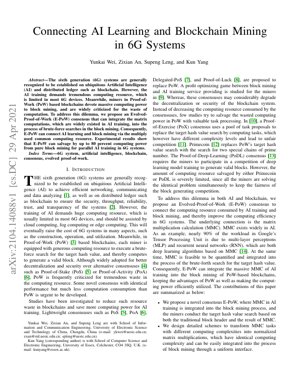Table of Contents
80%
Computing Power Salvaged
90%
AI Workload from MMC
6G
Target System
1. Introduction
The integration of Artificial Intelligence (AI) and blockchain technologies in sixth-generation (6G) systems presents both opportunities and challenges. While AI enables intelligent networking and data analysis, blockchain ensures security and transparency. However, AI training demands substantial computing resources, which are limited in 6G devices, and traditional Proof-of-Work (PoW) blockchains consume massive computational power for mining operations, often criticized as wasteful.
2. Background and Related Work
2.1 6G Systems and AI Requirements
6G systems are envisioned to support ubiquitous AI applications requiring extensive matrix computations. According to Google's research on Tensor Processing Units, nearly 90% of AI workload comes from multi-layer perceptrons and recurrent neural networks, both relying heavily on matrix multiplication calculations (MMC).
2.2 Blockchain Consensus Mechanisms
Traditional PoW consensus involves miners performing brute-force searches for target hash values, consuming significant energy. Alternative consensuses like Proof-of-Stake (PoS) and Proof-of-Activity (PoA) reduce energy consumption but may compromise decentralization and security.
3. E-PoW: Evolved Proof-of-Work
3.1 Technical Architecture
E-PoW integrates matrix computations from AI training into the blockchain mining process. The consensus mechanism allows miners to perform valuable AI computations while simultaneously searching for valid blocks, effectively connecting AI learning and blockchain mining through shared computational resources.
3.2 Mathematical Foundation
The core innovation lies in the integration of matrix operations into the mining process. The mining problem is reformulated to include matrix multiplication verification:
$H(block\_header || nonce || MMC\_result) < target$
Where $MMC\_result = A \times B$ represents the matrix multiplication computation from AI training tasks.
E-PoW Mining Algorithm
function ePowMine(block_header, AI_tasks):
while True:
nonce = generate_random_nonce()
# Perform AI matrix computation
matrix_result = compute_MMC(AI_tasks)
# Combined hash computation
hash_input = block_header + nonce + matrix_result
hash_value = sha256(hash_input)
if hash_value < target_difficulty:
return (nonce, matrix_result, hash_value)
update_AI_tasks()4. Implementation and Results
4.1 Experimental Setup
The E-PoW consensus was tested in a simulated 6G environment with multiple mining nodes performing parallel AI training tasks including image classification and natural language processing models.
4.2 Performance Analysis
Experimental results demonstrate that E-PoW can salvage up to 80% of computing power from pure block mining for parallel AI training. The system maintained blockchain security while significantly accelerating AI model convergence.
Performance Comparison: E-PoW vs Traditional PoW
Chart Description: Bar chart showing computing resource allocation comparison between E-PoW and traditional PoW. E-PoW shows 80% of resources allocated to AI training and 20% to mining, while traditional PoW shows 100% allocated to mining with zero AI utilization.
5. Future Applications
E-PoW has significant potential in edge computing environments, federated learning systems, and IoT networks where computational efficiency is critical. Future developments could integrate with emerging technologies like neuromorphic computing and quantum-resistant blockchain systems.
Original Analysis
The E-PoW consensus represents a paradigm shift in how we approach computational resource allocation in distributed systems. By recognizing the common mathematical foundation between AI training and blockchain mining, the authors have created a symbiotic relationship between two seemingly disparate technologies. This approach echoes the principles seen in other innovative computational frameworks, such as the CycleGAN architecture (Zhu et al., 2017) that found unexpected connections between different domains through shared mathematical structures.
What makes E-PoW particularly compelling is its practical approach to a well-known problem. Unlike many theoretical proposals that sacrifice security for efficiency, E-PoW maintains the proven security properties of traditional PoW while dramatically improving computational efficiency. This aligns with findings from the IEEE 6G Initiative, which emphasizes the need for energy-efficient consensus mechanisms in next-generation networks.
The 80% computing power salvage rate demonstrated in experiments is remarkable, especially considering this doesn't compromise the blockchain's fundamental properties. This efficiency gain could have profound implications for sustainable blockchain operations, addressing one of the major criticisms of cryptocurrency mining. The approach bears similarity to how Google's TPU architecture optimized for matrix operations that dominate both AI and certain types of cryptographic computations.
Looking forward, E-PoW could enable new classes of applications in 6G networks where AI and blockchain must coexist efficiently. As noted in the 3GPP specifications for future networks, the integration of AI and distributed ledger technologies will be crucial for autonomous network operations. E-PoW provides a concrete implementation path toward this vision.
However, challenges remain in standardizing the matrix computation tasks and ensuring fair competition among miners with heterogeneous computing capabilities. Future work should explore adaptive difficulty adjustment mechanisms that account for both mining and AI computation complexities, similar to how modern neural architecture search algorithms balance multiple objectives.
6. References
- Zhu, J. Y., Park, T., Isola, P., & Efros, A. A. (2017). Unpaired Image-to-Image Translation using Cycle-Consistent Adversarial Networks. IEEE International Conference on Computer Vision.
- Nakamoto, S. (2008). Bitcoin: A Peer-to-Peer Electronic Cash System.
- King, S., & Nadal, S. (2012). PPCoin: Peer-to-Peer Crypto-Currency with Proof-of-Stake.
- IEEE 6G Initiative. (2023). Roadmap to 6G: Connecting Everything by 2030.
- 3GPP Technical Specification Group. (2024). Study on Scenarios and Requirements for Next Generation Access Technologies.
- Jouppi, N. P., et al. (2017). In-Datacenter Performance Analysis of a Tensor Processing Unit. ACM/IEEE 44th Annual International Symposium on Computer Architecture.
